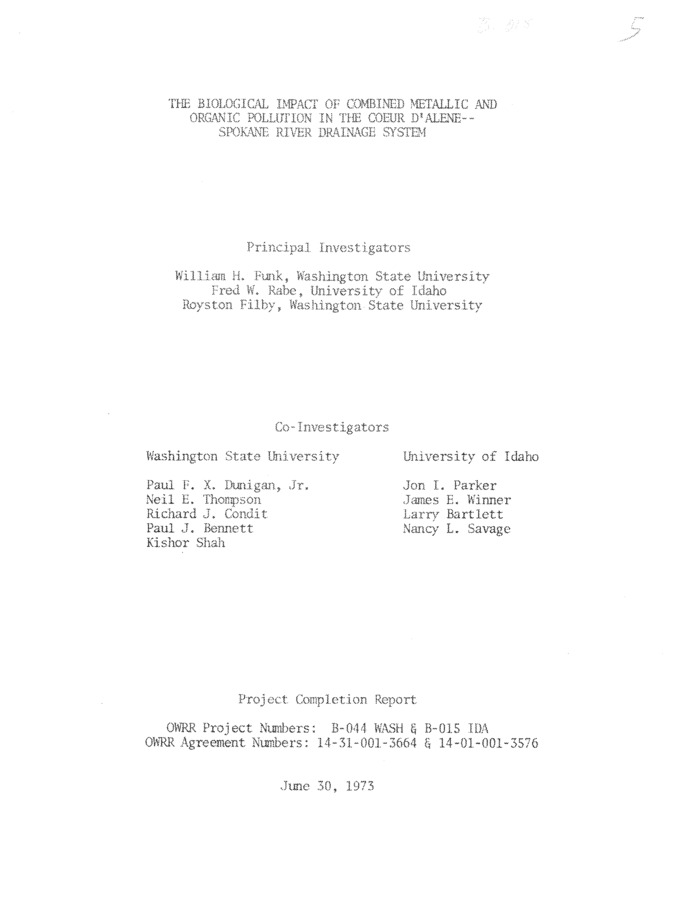PDF
Biological impact of combined metallic and organic pollution in the Coeur d'Alene-Spokane River drainage system. Project completion report, OWRR project no. B-044-WASH and B-015-IDA Item Info
- Title:
- Biological impact of combined metallic and organic pollution in the Coeur d'Alene-Spokane River drainage system. Project completion report, OWRR project no. B-044-WASH and B-015-IDA
- Authors:
- Funk, William H.; Rabe, Fred W.; Filby, Royston.
- Contributors:
- Co-investigators: Dunigan, Jr., Paul F. X.; Thompson, Neil E.; Condit, Richard J.; Bennet, Paul J.; Shah, Kishor; Parker, Jon I.; Winner, James E.; Bartlett, Larry; Savage, Nancy L.
- Date:
- 1973-06-30
- Description:
- An investigation was made into the biological effects of metallic pollution in the Coeur d'Alene-Spokane River Lake drainage system. Water quality data show heavy inflows of nutrients during late spring into Coeur d'Alene Lake from the St. Joe and Coeur d'Alene Rivers and Plummer Creek. Although no water devoid of dissolved oxygen have been measured, 2-4 mg/1 have been measured in the southern portion of the lake. Phytoplankton productivity measurements and bottom organism identification and enumeration have shown that the lake functions at several trophic levels, meso-eutrophic to eutrophic in the southern portion, mesotrophic in the immediate area of the Coeur d'Alene River and oligotrophic in the northern portions. High metal concentrations (1000-7000 mg/kg Zn) in the bottom sediment of the middle and northern portions of the lake did not appear to substantially affect distribution of benthic chironomids or ogliochaetes. Lake sediment cores taken across the delta region of the Coeur d'Alene River penetrated through the region of high metallic concentration and allowed an average sediment deposition rate to be calculated. Algal toxicity tests showed the amount of Zn normally present in the Coeur d'Alene River and Spokane River to be inhibitory to the algal test organism Selanastrum capricornutum. The water quality of the Spokane River was shown to be of good to excellent quality in all parameters tested except for high metallic content, especially Zn. Activation and atomic absorption analysis of metallic content in the tissues of the organisms populating the Spokane River indicated that the algae were the prime concetrators of Zn, Cd, Pb, Hg, Fe, and Mn. Algae and detritus consumers such as the larvae of caddisfly Hydropsyche and the nymphs of the mayfly Baetis reflected high metallic concentrations. Most higher aquatic plants showed relatively lower concentrations. Analysis of fish tissues showed considerably less concentration of metals than the aquatic plants, insects or algae. However, Zn was measured at concentrations of 80-200 mg/kg in liver tissues of several species of fishes. Fillet tissues generally contained less than one quarter of these amounts. The fish, when collected, did not appear under stress leading the investigators to believe that most of the metals--although present in relatively high concentration in the tissues of the organisms tested--must be in a relatively innocuous state.
- Subjects:
- benthos water quality heavy metals food chains aquatic environment
- Location:
- Spokane River; Lake Coeur d'Alene
- Idaho County:
- Kootenai County
- Latitude:
- 47.69
- Longitude:
- -116.81
- Collection:
- Coeur d'Alene Basin
- Source:
- Idaho Water Resources Research Institute, University of Idaho
- Identifier:
- IWRRI Number 197315
- Publisher:
- Idaho Water Resources Research Institute, University of Idaho
- Contributing Institution:
- University of Idaho
- Type:
- Text
- Format:
- application/pdf
- Cataloger:
- wbv
- Date Digitized:
- 2012
- Language:
- eng
Source
- Preferred Citation:
- "Biological impact of combined metallic and organic pollution in the Coeur d'Alene-Spokane River drainage system. Project completion report, OWRR project no. B-044-WASH and B-015-IDA", Idaho Waters Digital Library, University of Idaho Library Digital Collections, https://www.lib.uidaho.edu/digital/iwdl/items/iwdl-cda_funk_1973.html
Rights
- Rights:
- In copyright, educational use permitted. Educational use includes non-commercial reproduction of text and images in materials for teaching and research purposes. For other contexts beyond fair use, including digital reproduction, please contact the University of Idaho Library Special Collections and Archives Department at libspec@uidaho.edu. The University of Idaho Library is not liable for any violations of the law by users.
- Standardized Rights:
- http://rightsstatements.org/vocab/InC-EDU/1.0/

